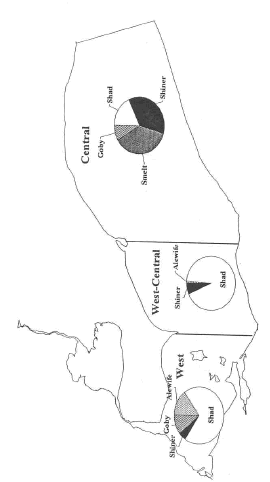
Walleye News & Fact File
Bag Limit Reduction
Proposed for WalleyeT
he Division of Wildlife at the annual Governor’s Fish Ohio Day July 19th announced its proposal to reduce the daily legal bag limit for walleyes. If approved by the Ohio Wildlife Council, more conservative creel limitations would included a daily bag limit of four walleyes from March 1 through April 31, and six walleyes the remainder of the year. The new regulations would also include Lake Erie tributaries up to the first dam or riffle.The current bag limit is 10 walleyes per angler per day.
The Ohio Wildlife Council is expected to vote on the proposed changes at its September 13 council meeting. If approved, the new regulations would take effect March 1, 2001.
The new limits are part of a cooperative strategy by the Lake Erie Committee of the Great Lakes Fishery Commission to strengthen the lake’s walleye population. The catchable walleye population is currently estimated at about 49 million fish, down from an estimated 60 million several years ago.
The annual lakewide total allowable catch will be significantly reduced from this year’s 7.7 million walleyes for three years beginning in 2001.
The Lake Erie Committee of the Great Lakes Fishery Commission is made up of fisheries managers representing Ohio, Michigan, Pennsylvania, New York and Ontario. Each of the other states and Ontario also agreed to institute reductions in sport or commercial harvest.
New Ohio State Record Lake Trout Certified
A
new state record lake trout was caught last April 20 by a Lake Erie angler, surpassing the previous state record by more that 3.5 pounds. Tom Harbison of Natrona Heights, PA was perch fishing on Lake Erie near Conneaut Harbor when he caught the 20.49 pound lake trout. Harbison was about one mile off shore in 48 foot of water and using 12-pound test monofilament line on a casting reel."At first I thought I had a burbot or a drum", said Harbison, a licensed charter captain. "But then after fighting it for awhile I thought it was a walleye. And after another four or five minutes, I just knew it was something big. I knew it wasn’t a steelhead because it would have broken water right away. Then when I saw it, I was really shocked to see it was a lake trout."
The record fish measured 34 inches long and had a girth of 23 inches. Biologists at the Division of Wildlife’s Fairport Harbor Fisheries Research Unit estimated the fish to be about 24 years of age.
"There were virtually no lake trout in Lake Erie from the 1960s through the early 1970s, said Carey Knight, fisheries biologist with the Fairport Unit. "Sea lampreys and loss of habitat reduced populations to near extinction. Lake Erie fisheries agencies began stocking lake trout in the 1970s and its possible that this fish was one of the early fish that were stocked."
The previous Ohio record lake trout of 16 pounds, 11 ounces was caught by Daniel Wilson June 6, 1993 from Lake Erie.
Gill Netter Charged with Fishing
in Ohio WatersT
hree people involved in a Canadian gill net operation were charged for using gill nets in the Ohio waters of Lake Erie this past May. Enforcement officers recovered seven illegally set gill nets in Ohio waters during a water/air surveillance project May 11th. The nets were in an area west of Middle Sister Island about 300 yards into Ohio waters.Gill nets, widely used in the Canadian commercial fishing industry, have been prohibited in the Ohio waters of Lake Erie since 1983.
Charges were filed in Oregon, Ohio Municipal court against Paolo Adragna of Leamington, Ontario, captain of the Canadian vessel Coranet, and Gaspare Adragna and Pierina Adragna, owners of the vessel, also of Leamington.
"The apprehension of the illegal commercial netter was the result of a joint surveillance operation, dubbed "Operation Kingfisher," undertaken by numerous agencies surrounding the lake," said Mike Budzik, chief of the Ohio Division of Wildlife. "Our agencies have stepped up efforts and will continue to work in unison to maximize efforts to stop future illegal commercial fishing activity in U.S. waters."
Agencies involved in the surveillance operation included the Division of Wildlife, Michigan Department of Natural Resources, Pennsylvania Fish and Boat Commission, New York State Department of Environmental Conservation, Ontario Ministry of Natural Resources, United States Coast Guard, and Unities States Fish and Wildlife Service.
The net locations were plotted using GPS systems. Twenty-three nets were seized, but only seven of the nets were found to be in Ohio waters. The required identification of the flag staff used to mark the nets indicated the nets were licensed to the Canadian vessel Coranet, that was located nearby in Canadian waters.
What Are Walleye Eating
In Ohio Waters?In the central basin the walleye diet shifted to a combination of shiners (37%) and smelt (37%) and shad (20%) was a secondary prey item. Round gobies (9%) were also present in the diets of walleye from the central basin.
